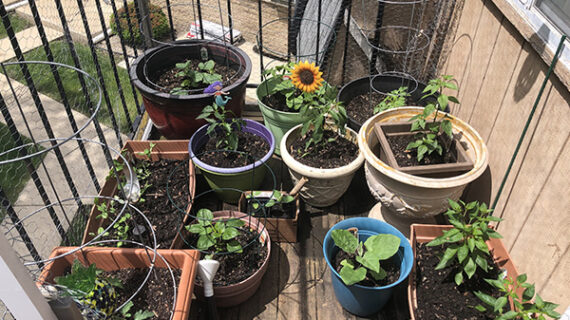– Welcome everyone, Wednesday Nite @ the Lab. I’m Tom Zinnen. I work at the UW-Madison Biotechnology Center. I also work for the Division of Extension Wisconsin 4-H. And on behalf of those folks and our other co-organizers, PBS Wisconsin, the Wisconsin Alumni Association, and the UW-Madison Science Alliance, thanks again for coming to Wednesday Nite @ the Lab. We do this every Wednesday night, 50 times a year. Tonight, it’s my pleasure to welcome back to Wednesday Nite @ the Lab, PJ Liesch. He’s the director of the Insect Diagnostic Lab in the Department of Entomology here at UW-Madison, and with the Division of Extension. PJ was born in Racine, Wisconsin and went to J. I. Case High School there. Then he went to UW-Parkside to study biological sciences. In 2007, he came to Madison to get his master’s degree in entomology. And in 2014, he became director of the Insect Diagnostic Lab here. Tonight, he’s gonna speak with us about tracking insects across Wisconsin during the pandemic year. Would you please join me in welcoming PJ Liesch back to Wednesday Nite @ the Lab
– Well, thank you very much, Tom, for that introduction. It is a pleasure to be here talking to you today about some of the main insect trends that I’ve seen come through my lab over the course of the pandemic. Now, before I talk about those insect trends, I do wanna provide a little bit of background information about the UW Insect Diagnostic Lab. So the lab itself was established in the late 1970s as a way to help residents of Wisconsin get insects and other related arthropod creatures identified. This could include ticks, spiders, centipedes, millipedes, and so on.
And so that’s my main day job is identifying insects and arthropod samples for folks around the state and sometimes beyond the borders of the state as well. This is a free service to residents of Wisconsin, and it typically has a turnaround time of one to two business days. Some other things at the lab that I’m involved with, I provide management advice if it’s a situation where an insect you consult with me about happens to be a pest. But one way or another, it means I’m getting a lot of really interesting insect samples in the mail, as well as digital photos of insects sent to me by email. And that’s how I handle the majority of my cases at the lab. Some other things that I’m involved with quite a bit would be entomology-related outreach and education. For example, I’m a regular guest on Wisconsin Public Radio’s The Larry Meiller Show. I have a lot of media contacts, and I’m involved in general with a lot of outreach and educational programs, both on and off campus. And then lastly, I also have a teaching appointment here on campus as well. So having said that, I interact with a lot of residents of Wisconsin throughout the course of the year, and also not only through speaking with them, but by identifying insects and other related creatures for them, it gives me a pretty neat perspective in terms of what are the trending insects in Wisconsin, both within a year, but also over longer periods of time as well.
Now of course, when the COVID pandemic hit, it impacted myself and my own job, just like many Americans out there. So in March of 2020, as an example, I started working remotely from home. Luckily, you can see from my home office on the right-hand portion of the screen, that I was already set up with microscopes that I’ve had for years. So I was able to, through the course of the pandemic, visit campus once or twice a week, or more often as needed. And then I would pick up and in a short period of time, process and kind of triage samples and then take home some of the samples that needed additional microscope work on. So I was on campus a little bit during the course of the pandemic, but mostly working remotely. This also meant a shift to remote and virtual outreach and educational events. So if you’ve listened to me on Wisconsin Public Radio sometime during the course of the pandemic, there’s a good chance I was probably located in this room on the bottom left-hand corner of the screen. That’s a little reading room off the side of our living room, and it happened to be the spot in my house where I had the best phone reception. So if you called into Larry Meiller’s show, I might’ve been sitting on that very couch right there.
There also were other shifts in outreach efforts to doing a lot more virtual webinars and educational events via Zoom and WebEx and Skype and things like that, similar to many other Americans as well. However, in terms of my day-to-day work at the Insect Diagnostic Lab, one of the big questions that I had was what would be the impact of COVID on caseload. If people were simply staying at home, would it mean that I would see fewer requests and less demand overall? I’m going to get into some of these statistics from the lab in the next couple of slides to give you a better idea of how we can go about answering that question. So to do that, let’s look at some statistics pre-pandemic. So these are some lab stats from the year 2019, before COVID hit us. You can see in that year, I handled just over 2,500 cases. So again, that could be a physical sample, an email with a digital photograph of an insect, or in some cases, simply conversing with someone and asking them questions to try and figure out what insect they are seeing or related creatures as well. Now in 2019, I did handle cases from all 72 of Wisconsin counties, and the vast majority, about 95% of all my cases originated from Wisconsin. I do live a little bit vicariously through cases from other states. In 2019, I handled cases from about 40 other U.
S. states and about a dozen foreign countries as well. Now when we look at the sample format, so what is the format of the specimen that actually comes to me? In most cases, this involves digital images. About 60 to almost two-thirds or so of all my cases involve digital images. And if you think about it, that makes sense. And in the long-term, this has been increasing over time, especially with the invention of digital cameras and smartphones, because these days, most folks have a smartphone with them, meaning they may have an 8, 10, 12 megapixel camera handy at their disposal, so they can take a picture of an insect, send it to me, and in a lot of cases, as they say, a picture’s worth a thousand words. And if I can zoom in on a screen, I can often identify many insects just from good digital photographs. Still though, about a third or so of my cases involve physical samples. So that would be where someone is actually mailing me a sample in the mail, or in a lot of cases, folks that live in the general Madison area will come into the lab and drop off samples. So that is another common route that I get samples at the diagnostic lab.
And then in terms of who is submitting the samples, the biggest chunk of the pie, about half or so comes from the general public, about a quarter comes from colleagues in Extension offices located around the state of Wisconsin. And then other samples come in from a variety of other groups, such as the green industry, which includes tree and shrub and lawn care companies, pest control professionals, medical professionals, and sometimes government agencies as well. So that gives you a snapshot of the Diagnostic Lab pre-pandemic. Then when we look at the Diagnostic Lab during the pandemic years, we see that overall caseload and demand essentially stayed about the same in 2020. Very similar caseload numbers to pre-pandemic time. So about 2,500, and at the moment of this recording, November of 2021, I’ve got over 2,300 samples for the year thus far. So really, demand has remained high for services at the Insect Diagnostic Lab during the pandemic, but there have been some notable shifts. Now in terms of where the samples are coming from, again, most from Wisconsin, about 95%. And I did handle cases from all 72 counties at this point. And then some other areas, other states and other countries as well.
One thing that stands out to me though, is some of the shifts in terms of the format of the samples. In 2020 and 2021 during the pandemic, I saw a distinct increase in the number of cases that involved digital images and a distinct drop in cases that involved physical samples. And I think that makes perfect sense in light of COVID. Many folks were working from home, working remotely, so they weren’t necessarily going out with their normal day-to-day activities. Also for a while, due to building closures on campus here, my building, for example, wasn’t open to the general public. And so people couldn’t simply come in and drop off a sample or individuals maybe were reluctant to head to the UPS store or post office to be able to mail a sample in because of the threats posed by the pandemic. So I did see an increase again in digital submissions, a decrease in physical sample submissions that were sent in. But still, it was about 20 or so percent of the case load that I’ve handled during the pandemic period. And then we also saw some shifts in the demographics. We saw a big increase in cases submitted by the general public and likewise, a decrease in cases submitted by colleagues in Extension.
And that also makes sense to me. During the course of the pandemic, a lot of county Extension offices, the buildings may have physically been closed, or there may be a greatly reduced presence in those offices. However, if you’re like me, you might’ve been working home during the pandemic for quite a bit of it. And as a result, you might’ve been spending more time in your yard or in your garden or walking around your neighborhood or nearby hiking trails. And I think folks simply had more opportunities to notice insects, and they had questions about what they were seeing out there. So there were some shifts in the demographics and the formatting of samples that I handled at the lab during the pandemic years. There also were some interesting trends that I’ve seen overall in light of the pandemic. So if you’re like me, you’ve maybe switched to doing curbside pickup for groceries or day-to-day goods, that sort of thing. And so I feel Americans in general have a lot of shipping of goods coming from overseas in some cases. You know, you can go on websites and get easy two-day delivery, for example.
And along with that, with all this movement of human goods, I did see certain insects pop up a little bit more because of this, so on this slide is an example. On the left we can see the American roach. This is a common roach species, especially in the southeastern part of the U. S. We do have them here in Wisconsin to a limited extent, but they’re not particularly common. There is a closely related species called the Australian roach, which I rarely see here in Wisconsin, though. It really does better in tropical and subtropical areas, and it can be distributed pretty widely around the globe. However, since the COVID pandemic started, I did have a number of cases of this particular roach species coming through my lab doors because essentially, individuals would order something and in some cases, it might’ve been shipping directly from southeast Asia and coming to their doorstep, and inside might’ve been one of these insects. So I saw some cases like that, which definitely piqued my interest. Another example along these lines, this is a situation where someone had purchased online some reusable bamboo drinking straws, because they wanted to be more sustainable overall rather than using plastic straws.
But when they received the straws in the mail, it turned out that they noticed some damage and tiny insects inside, which they got in touch with me. We got a physical sample under the microscope, and were able to identify it as a species called the bamboo borer. And this is a species native to parts of the world such as southeast Asia. And it can be a significant pest of bamboo. So I think it’s another good example of how humans can move insects and other organisms across the planet. So now what I’d like to do is really dive into some of the main insect trends that we saw here in Wisconsin across the pandemic period. And just again, to give you my perspective on this, I’m getting ideas of these trends both from caseload at the lab directly, but also conversations with folks around the state of Wisconsin. And what I’d like to do is walk you through some of the main groups of insects and talk about and highlight some of the main insect trends that I’ve been seeing the last couple of years. So the pandemic was certainly unusual for all of us to deal with, and right around the time that the pandemic was starting to get going, I was dealing with a very unusual insect case, which involved a type of beetle called blister beetles. And these can be somewhat common here in Wisconsin if you know when and where to look.
It’s a pretty small family of beetles, but we do have a number of species in our area. However, one interesting thing about blister beetles is that they can contain a defensive chemical called cantharidin, and cantharidin can actually cause blistering of skin and other membranes if you are exposed to it. So this is an insect that you would not want to squish on your skin because it could cause some very severe irritation. Now it turns out that horses are very sensitive to this defensive chemical cantharidin. And right around the time the pandemic got going, I was dealing with a case that involved horses in central Wisconsin, and actually a shipment of hay that came from out west that happened to contain some blister beetles. And a sample was submitted to me, I was able to identify some under the microscope, which helped strengthen the suspicion of what was going on in this particular situation. It was a tragic event overall, because there were a dozen or more horses that were affected, but it is an example of a very unusual case that I saw come through my doors at the Insect Diagnostic Lab. Now, there’s a very common family of beetles called the scarab beetles. And these are well known from ancient Egyptian hieroglyphs and things like that. But we have many species in our area, and some of these species can be notable plant pests.
So if you live in a part of the state with sandy soil, you might bump into this particular insect called the rose chafer, which can be active in late spring and early summer, essentially the month of June. And by about early July, they tend to tail off for the year and wrap up. Now, one trend that I’ve been seeing the last couple years during the pandemic, probably weather-related, is I haven’t seen nearly as many reports of these compared to a few years ago. So we have perhaps gotten a little bit of reprieve. A somewhat similar story with this creature, Japanese beetle, which is a well-known garden pest that many folks around the state of Wisconsin have to deal with. They have been very abundant in certain parts of Wisconsin for the last decade or longer, but one trend that I noticed, especially in the second year of the pandemic in 2021, is that their numbers seem to be much lower than usual, essentially statewide. They were certainly still out there causing some problems for us, but I did notice a distinct drop in cases and reports of these in the second half or second year of the pandemic. One other trend though I’d like to mention about Japanese beetles. If we look at this map of Wisconsin here on the right-hand portion of your screen, you can see that black dotted line. And if you are below, to the south of that line, Japanese beetles at this point are really pretty well-established and widely distributed.
But one trend that I’ve been seeing over the last couple of years and really longer than that, the last five to 10 years or so, is a northwards push of Japanese beetles. So during the pandemic years, I have had cases from areas such as Hayward and Spooner. So like Washburn and Sawyer counties, we’ve had some reports even from up in Bayfield County, which is pretty much as far north as you can get in the state, as well as north central, northeastern Wisconsin, places like Oneida and Vilas counties. And then just for reference, even though it’s another state, but places like Marquette, Michigan have seen a little bit of activity out there. So even though we had a little bit of reprieve from garden and landscape plant damages last year, overall, this insect does seem to be expanding its range in Wisconsin and in the Midwest in general. Another scarab beetle worth mentioning, this is called the Asiatic garden beetle. And it has a story somewhat similar to Japanese beetle in that it’s not native to Wisconsin or North America. It actually comes from Asia, and this species got into the eastern part of the country in the early 1900s around New Jersey area. And over time, it has been steadily spreading westward. And this pest is worth mentioning because it can cause some significant damage to agricultural crops such as corn.
And it also can be a nuisance pest on landscape trees and shrubs. And what they do is they feed primarily at night, and they can bite holes and chunks out of leaves and cause damage that way. Now the reason I’m mentioning this particular scarab beetle, is 2021 marked the first year that we had ever found and collected specimens of this species in the state. So back in July of 2021, a handful of specimens were collected on the west side of Dane County in southern Wisconsin, and then another specimen was collected in September of that year. So it seems to be active at a period of the year similar to Japanese beetles, July through September, but it is something new that has shown up in the state during the pandemic period. Now let’s shift gears and talk about some other beetles. The emerald ash borer is an insect that I have been watching throughout my entire entomology career. And actually EAB or emerald ash borer is essentially my gateway bug. When I was a college student, this was an insect that really got my foot in the door to become an entomologist. So I’ve been following it and studying it now for over 15 years at this point.
And it’s really come full circle. This is an insect that I have now seen show up in the state, cause significant damage in the state, and it’s continuing to do that. Even though it has been present in some parts of Wisconsin for many years, it is still expanding into new areas. And I’ll talk more about that on the next slide. But if we look at some of the spread information from the last couple years during the pandemic, we can see that in the year 2020, it was detected in six new counties here in the state, and in 2021, 3 new counties. So at this point, it brings us up to 61 out of the 72 counties in Wisconsin have confirmed detections of emerald ash borer. So there’s still about 10 or so counties where EAB has not been found. However, when you look at where those new detections are located, it’s essentially the more northern portions of the state. And so this slide here and this map will help illustrate this a little bit further. What this map shows in green or blue are locations where emerald ash borer has been confirmed.
The pale yellowish areas are locations where emerald ash borer has not yet been detected. So when I look at this map, it tells me a couple of important things. The first thing is that the southern third of Wisconsin has a very heavy and widely distributed infestation of emerald ash borer. It’s essentially in every township in the southern third of the state. And well-established, causing lots of damage in those areas. When we look at the middle third of the state, so about halfway up north and south, that band in the state, it’s about a 50/50 mix of areas where emerald ash borer has been spotted and areas where we have not yet detected it. But then what scares me is the northern portions of the state, where emerald ash borer, its distribution is essentially pins on a map at this point. It’s known from smaller, isolated areas. And also when you look at northern Wisconsin on this map, most of the land area’s yellow, telling me that emerald ash borer has not yet been found there. The reason that this is alarming is if you look at numerically the number of ash trees that we have here in the state, most of them are in the northern part of Wisconsin.
There are certain ash tree species, for example, like black ash that can do very well in swampy areas in northern portions of Wisconsin. And in some of those locations, black ash may make up 75% to even perhaps 90% of the trees in a given area. So what that tells me is that emerald ash borer has been wreaking havoc in parts of Wisconsin for many years, but it still has a big area to expand into. And it’s something that we are going to continue to see trending and expanding its range, not only for years to come, but really, we’re gonna be watching this play out for decades to come. A couple other invasive beetles that I’d like to mention. This is the lily leaf beetle, which first showed up in Wisconsin back in 2014. And it’s a rather conspicuous-looking insect. The adult beetle is shown in the upper right-hand corner and they’re bright red. And these are pests of lilies, specifically true lilies, which can include a number of lily hybrids, but they don’t attack day lilies, which are actually a different genus of plants. However, the adults and larvae can cause very significant damage to true lily flowers, which are often planted in yards and gardens.
So it’s a very popular plant, but because this insect can be so damaging, there are now certain areas in Wisconsin where commercial flower growers and nursery operators are no longer growing true lilies because of this pest alone. Now to give you a little bit of perspective and a little bit of background information, when we look at the map on the left, you can see as of 2018 where lily leaf beetle has been found. And the original infestation occurred in Marathon County in the general Wausau area. So there had been a little bit of spread between 2014 and 2018. In 2018, we saw it spread to a couple of new counties to the east, but then in 2019, we saw some really big range expansions. We saw some northward expansion to the northwest, but then some big jumps on the map. Over towards the Twin Cities area, lily leaf beetle showed up at the very tippy top of Door County. And then it was also detected down in Dane County that year. So what that tells me is that humans likely move the insects by moving infested plant materials. And so that’s an illustration of how humans can move pest insects around the state.
So when we go from 2019 to the pandemic years, we can see some additional spread throughout that core area. But we also see some jumps on the map such as to locations in southeastern Wisconsin, like Milwaukee and Waukesha County. So again, this insect has increased its range and this map does hold true in 2021 as well. So that’s the status of this insect during the pandemic year, as it certainly has spread around the state and is starting to cause more problems for home gardeners and landscapers. There’s a very closely related beetle called the viburnum leaf beetle, which instead of lilies, it attacks viburnum shrubs, which can be common landscape plants. And there’s a very wide range of viburnum species and cultivars. Unfortunately some, such as our native species, tend to get severely damaged by this insect. There are some other types of viburnums that aren’t damaged as much. Similar to lily leaf beetle, this pest showed up in the state of Wisconsin about five or six years ago, but when this one showed up, the epicenter for it is really southeastern Wisconsin. So the area where the four counties of Milwaukee, Waukesha, Washington, and Ozaukee Counties meet, that would be the bullseye on the Wisconsin map.
But we can see that by 2018, we’re starting to see a little bit more activity in southeastern Wisconsin. By 2019, for example, some more activity in southeastern Wisconsin, as well as Dane County. And then a big jump up to the Hurley area in Iron County and across the border in Ironwood, Michigan. So there have been some jumps on the map, and likely this is due to humans moving this insect around. And then if we look ahead to 2020, we also see some expansion in terms of northward spread towards Sheboygan County, but also a jump up towards the Green Bay area in Brown County. And then the most up-to-date map here in 2021 during the pandemic, we saw some spread in north central Wisconsin, but also another jump on the map to the Wausau area in Marathon County. So some parts of the state are now having to deal with a number of invasive and damaging beetle species that have been trending just over the last couple of years. A beetle that needs very little introduction, most of you probably know this as the lady beetle or ladybug that sneaks into your house in the fall. This is the multicolored Asian lady beetle, which can actually be a beneficial predator of insects, such as aphids during the warmer months out on plants, including crops. However, in the fall, they have the habit of seeking out sheltered overwintering spots.
And that can mean that they sneak into people’s homes, garages, and other structures. Now we have really seen some interesting trends with this insect during the course of the pandemic. So pre-pandemic, their numbers had been generally fairly low in many areas. In 2020, I suspect due to weather and other conditions that year, we had lots of reports of this particular lady beetle during that year. However, we saw almost a complete reversal in 2021. And in this last year in 2021, I saw very few reports of this insect overall. So it does make me suspect that at least in this last year, the dry, droughty conditions of 2021 might’ve impacted its overall population levels. Now, switching gears to talk about our next group of insects, the order Diptera. These are the true flies, which are insects such as houseflies, horseflies, deer flies, and other biting pests, such as mosquitoes. And mosquitoes are probably the commonest true fly that Wisconsinites seem to deal with on a regular basis.
And we do see these every single year, although their populations can vary of course from year to year. Now, just to give you a little bit of background, mosquitoes are aquatic during their juvenile stages. So the larvae and pupae need to be in water of one kind or another. And in general, if we have a year with average or above average precipitation, we tend to see a lot of mosquitoes. So that’s the story we saw pre-pandemic in a year like 2019. During the pandemic though, in 2020, mosquito pressure really depended on where you were located in Wisconsin. We had some variability with rainfall patterns and things like that. Some places such as northern Wisconsin just had a lot of mosquitoes in 2020. Other places, not nearly as many as prior rainier years. In 2021 though, it was a really interesting mosquito situation simply because of the dry, droughty conditions.
We didn’t have a lot of water for the juvenile stages to develop. So if we look at the bottom right-hand corner of the screen, there’s a map from June, from the U. S. Drought Monitoring Service. And you can see at that point that most of the state was either unusually dry or in some stage of drought. So we simply didn’t have enough rainfall for there to be large numbers of mosquitoes in periods of the year, such as late spring and into the summer months. Whereas historically, we often see a lot of mosquitoes around the time of Memorial Day. In 2021 though, what essentially happened is that we saw a shift in mosquito pressure to a little bit later in the year because we did start getting some more rainfall in months such as August and September. So we started getting an increase in reports that time of the year. Now some good news to all this, so the last couple years, we’ve had very few cases of West Nile Virus, which is certainly good news.
We did however in 2020, have a couple of cases of eastern equine encephalitis, which can be a very serious disease. And there was one fatality that year. One other interesting story related to mosquitoes. So believe it or not, in Wisconsin, we actually have over 50 different species of mosquitoes. Each with their own unique biology and habits and things such as what animals they like to feed on. But to the naked eye, most of those mosquito species look about the same. Same size, same general coloration for the most part. So you often need to get them under the microscope to be able to actually identify them. However, the last couple years, I’ve seen many reports of this species shown here on the bottom right. This is our largest mosquito species in Wisconsin, called Psorophora ciliata, also known as the Gallinipper mosquito.
And these are about double the, triple the size of most of our other mosquitoes. And they seem to do really well. I see a lot of reports later in the summer after we have had some heavy rains. And so during the last couple years, over the course of the pandemic, I’ve had lots of reports of those, especially later on during the summer and late summer season. Switching gears to another fly that happens to be a blood-feeding type. These are black flies, which like mosquitoes are larvae, are aquatic during the larval and pupal stages. Although they develop in moving water such as streams and rivers, but when the adults are out, they do take blood meals. We actually have about two dozen different species of these. And a few of them will go to humans for blood. And the last couple of years have been very good years for black fly activity.
One shift that I saw during the pandemic years was in 2021, I saw activity a little bit earlier in the spring than what I normally would, I think simply due to some of the early warm spring temperatures that we had. That may shift their phenology a little bit, but biting flies such as black flies have been very abundant in the state the last couple years. And then the last fly I’d like to talk about is an insect called the boxwood leafminer. And this is a really unusual type of insect. They are teeny, tiny, little insects that live inside of the leaves of boxwood shrubs. And boxwoods are these lovely evergreen shrubs. They’re very common landscaping plants. What can happen though, is that this particular insect has larvae that live internally within the plant leaves and feed and cause damage that way. So the best analogy I can think of, if you think about the plant leaf as an Oreo cookie with your upper and lower epidermis, those would be your cookie layers. These insects essentially live in the frosting layer.
They live and feed internally within the plant. Now what can happen is they use their mouth parts to scrape away and feed on the internal plant structures. This can actually make a little bit of audible noise. And if you have hundreds or thousands of these inside the leaves of your boxwood shrub, it can actually sound somewhat like a box of Rice Krispies that you’ve poured into a bowl and added some milk to. You get that snap, crackle, and pop because of these insects. Now, one thing that’s interesting to me is I have seen more cases of these the last couple years, although I don’t necessarily think that their populations are increasing. There’s another thing going on behind the scenes. And that involves my colleague, Dr. Brian Huddleston, who is the director of the UW Plant Disease Diagnostics Clinic. And in the state of Wisconsin, there’s a newer disease called boxwood blight, which has shown up fairly recently.
And that disease can cause significant damage, including plant death, to boxwood shrubs. As a result, Brian Huddleston at the Plant Disease Lab has been seeing a lot more boxwood samples. And sometimes the damage caused by boxwood leafminer can resemble diseases to the naked eye. So as a result of that disease, I have been seeing over the last few years, an increase in boxwood samples at the Insect Diagnostic Lab and more cases of these. But again, I don’t think that boxwood leafminers are necessarily increasing in Wisconsin. Now let’s switch gears and talk about a group of insects called the order Hymenoptera. These are the ants and bees and wasps and primitive relatives called sawflies. And perhaps the biggest story, one of the biggest insect stories overall during the time of the COVID pandemic is this insect, the Asian giant hornet, which to date has never been found here in Wisconsin. At the moment, it’s only known from far northwestern Washington state and very nearby parts of British Columbia. Yet this insect has gotten a lot of attention in the media, and sometimes it’s been referred to as the murder hornet because of its potent sting and as a result, many diagnosticians that identify insects around the U.
S. have been swarmed with reports from individuals thinking they’ve found Asian giant hornets, but it ended up being a common look-alike insect. And I’ll expand upon that a little bit more in a coming slide. So just to keep you updated on the current situation as of late 2021, this is the map of the Asian giant hornet in North America. It is only known from far northwestern Washington state and nearby parts of British Columbia in Canada. So to date, there have been no sightings confirmed in Wisconsin or any of the surrounding states near us. And the closest known detection is at least 1,400 to 1,600 miles away from us, depending on where you’re located in the state of Wisconsin. So really, these insects do not pose a threat to us here in Wisconsin. Now, as I mentioned a moment ago, because of the media hype about the so-called murder hornet or Asian giant hornet, folks have been maybe a little bit on edge thinking about it. And they have bumped into some native insects around here that due to their large size, might look a bit similar.
So over the last two years, I have had a flood of reports along these lines. And in every single case, it ended up being one of these common look-alikes. That again, because of the large size, might be mistaken with the Asian giant hornet. So the commonest one I saw by far is in the upper left-hand corner. That’s called the cicada killer wasp. They are solitary, ground-nesting wasps that hunt cicadas and bring them back to their nest. And that’s what the larvae develop in and feed upon as a food source. Even though these insects are large, they might appear intimidating in that regard, but they’re actually quite docile and unlikely to sting. So really pretty harmless to humans. A somewhat similar story to the insect in the upper right-hand corner.
This is the great golden digger wasp, which I’ve also had lots of reports of during the course of the pandemic because of the Asian giant hornet story. This is another solitary, ground-nesting wasp, very docile and unlikely to sting. And then the final one at the bottom of the slide is called the pigeon horntail. And that insect can be about two inches long, which will certainly get your attention. And it looks like it has a very long stinger attached to the body. However, this insect is not capable of stinging. That’s actually a structure technically called an ovipositor, which is essentially their egg-laying device. And for that particular insect, what the female does is she goes to decaying, either standing or fallen trees. And she saws into the wood with that ovipositor and lays her eggs in the wood. And then the larvae of that insect develop inside of the decaying wood.
So it’s a very common insect overall. And like the other two, it’s generally quite harmless to humans. But again, with all the news attention about Asian giant hornets, I’ve had a lot of reports of look-alikes over the course of the pandemic. Now, if you’re like me and you’ve spent a lot of time at home during the pandemic, you might’ve been walking around your neighborhood more or hitting up local hiking trails and that sort of thing. And if you’ve been walking your neighborhood more, you might’ve bumped into these ants called pavement ants, which overall are one of the commonest ants I see reported every year in Wisconsin. However, I did see a few more reports than usual during the pandemic, and I think it’s because folks were just walking their neighborhoods more and getting out to stretch their legs because they were working from home. Now, if you’ve seen a scene like this, this can be very common at certain times of the year, especially in spring, for example, or early summer, these pavement ants have overwintered in the ground and they come up above ground, and colonies essentially fight with each other to try and duke it out for territories. So if you’ve ever walked down the sidewalk and seen this phenomenon, it’s most likely colonies of pavement ants duking it out for territory. Another interesting ant example, very relevant to the pandemic would be odorous house ants, which are ants that love sweet, sugary materials. So they often can sneak indoors looking for food.
However, this insect has a neat trick associated with it that can allow for pretty easy diagnostics. And especially during the pandemic era, when folks maybe didn’t want to head into the post office to mail in a sample, there’s essentially a quick and dirty trick that can help you identify these ants. And so I ended up communicating this quite a bit to clients over the course of the pandemic to help them specifically identify this ant. And the trick with it is that these ants have a rather peculiar odor if you are to crush them with your fingers. They smell somewhat like coconut or pia colada. And sometimes folks think that it smells more like a blue cheese odor associated with it. So they do have this rather unique odor, which we can then use as a diagnostic clue to identify this particular ant species. So that has helped me out in my line of work during the pandemic years when it was a little bit harder to get samples sent into the lab. And then the last member of the order hymenoptera I wanna talk about are some of our social wasps, which need very little introduction because we’re all generally familiar with paper wasps, yellowjackets, and bald-faced hornets. These can be very common every year.
And like previous years in 2020 and 2021 during the pandemic, I saw lots of reports of these. One trend though, that I’ve been watching over time, and I did notice this especially in 2021, getting some reports of these pretty late into the season. So typically, these insects have what we refer to as annual colonies. They establish new colonies every spring, and those colonies naturally die out in the fall, basically due to starvation and a frost at some point. The cold temperatures kill them. So in some parts of the state, this may happen in late September or sometime in October that those colonies die out. However, with some of the warm temperatures we saw in some parts of Wisconsin in 2021, had a first frost occur several weeks after when they typically would that essentially extended the season for us. And as a result, I saw a little bit of an increase in very late season reports of these insects, this particular year in 2021. Moving on to another large group of insects, the order Lepidoptera, so these are moths and butterflies. And we know the larvae as caterpillars.
One of the biggest stories to come out of this group this year involves this insect, Lymantria dispar, which historically had been known as the gypsy moth. However, that insect’s common name does refer to a specific ethnic group, so it’s no longer being used. There is actually a committee for the Entomological Society of America that is reviewing proposals for new common names, which will be released sometime early in 2022. But at the moment, we’re simply referring to this species by its scientific name, Lymantria dispar. Again, formerly known as the gypsy moth. And when we look at the history of this insect in Wisconsin, things had really been quiet for us for quite a while, no major reports of damage to trees, either landscape or forested areas for almost a decade or so. About 2010 was the last big issue we had with these in terms of widespread defoliation. So to give you some perspective, 2019 was a pretty quiet year. And that makes sense, because anytime you have a year with average or above average precipitation or rainfall, there is an introduced fungal pathogen called Entomopahga maimaiga that can specifically kill off gypsy moth caterpillars. So that’s what we see in this bottom center photo on this particular slide here.
Now in 2020, I did notice a bit of an increase in this insect in Wisconsin, but then in 2021, I saw a very dramatic increase in the number of reports of caterpillars, caterpillar damage, the adults, and also the egg masses, which are photographed on the right-hand portion of the slide. So this is an invasive pest that can cause widespread damage to forested areas. They like to feed on hardwood trees, such as oaks as an example. So they can be very destructive if they are abundant. So we’re starting to see this upward trend in 2021, which makes me a little bit afraid for future years, 2022, 2023, what is going to make or break the storyline, so to speak, is probably going to be the weather. If in coming years, we have a lot of rain in the spring, that’s probably gonna help us out because that fungal disease will help control and kill off their populations. But if things remain dry in future years, that may lead to further increases. And just to illustrate that point further, if you look at the egg mass, which is being laid by a female moth on the right-hand portion of the screen, those egg masses are light brownish or beige, fuzzy, and they’re about an inch and a half to maybe even two inches in length. And each of those egg masses can easily contain 500 to 1,000 eggs. And some areas near where I live, I have seen landscape trees that can easily have dozens or hundreds of these egg masses.
So as an example, if you have a hundred egg masses from this insect on a tree and all those hatch with a thousand eggs, you could have an oak tree, for example, with 100,000 hungry caterpillars on it next spring, so they are able to increase their populations rather quickly. So this is something that colleagues in Department of Agriculture and DNR are also keeping a close watch on around the state of Wisconsin for the foreseeable future. Another non-native pest, although much less destructive in the grand scheme of things. This is a species called the Purple Carrot Seed Moth, which I’ve been watching now for a couple of years. It showed up about three, four years ago in eastern Wisconsin, and at this point, this insect is pretty well-established in the southeast corner of the state. Although in 2021, it did make a jump over to west central Wisconsin as well. Now the adult moths are small. They’re about a third to a half of an inch long, beige around the head with grayish wings, pretty nondescript in appearance. What you’re probably more likely to notice would be the larvae, which are these small, half-inch long caterpillars. They either have a greenish or reddish appearance with very distinctive polka dots on the body that are white.
So a very unique-looking caterpillar, and these feed specifically on plants from the carrot family. So that can include things like carrots, Queen Anne’s lace, dill, parsnip, and things of that nature. And what the caterpillars do is they feed on the umbels or the bell-shaped flowers, and they specifically use silk and webbing to tie together parts of the flowers. And then they feed on those materials. So from an aspect of plant health, they don’t cause that much damage overall, but they can damage developing seeds. And also if it’s a plant such as dill, which seems to be the commonest plant this one’s been reported from, they can damage those plants and make them so that they’re no longer usable for culinary or cooking purposes. So this is something new that I have seen trending over the last couple years, including during the pandemic years as well. Now, switching gears to talk about a butterfly, a very well-known one, monarch butterflies. They’re very charismatic and well-known by pretty much everyone, but this insect has been trending for quite a while. And unfortunately, this is a downward trend that we’re not happy to see, but you can look at the population trends over about the last 20 to 30 years for Monarchs.
And there’s a pretty distinctive downward trend that has been going on. And the way that scientists measure this, rather than trying to count butterflies during the summer months, they wait until they migrate down from the eastern half of the U. S. and head down to forested mountainous areas outside of Mexico City. And when they do that, the monarchs pack in very densely and scientists are able to estimate the area that they occupy and thus gauge how their populations are doing. So that’s how we can tell that they seem to be declining. Because of this decline, it’s caught the attention of the federal government, which has recently reviewed possibly listing monarch butterflies on the endangered species list. And they did release their final report in 2020, in December of that year. And their ultimate declaration was that a being listed as an endangered species is warranted, but precluded. And that’s a little bit scary to hear about.
What that essentially means is that the government has said, yes, it’s warranted, they do need protection. The precluded part means there are many other species in line in front of them that need to be protected first, about a hundred or so other species. So it means unfortunately that monarchs are currently waiting in line to potentially be listed as an endangered species. So this is an unfortunate trend that we have been seeing going on across the monarch population in the eastern U. S. Another butterfly, which trended quite a bit in 2021 in certain parts of the state. This is the hackberry emperor, which was very abundant in south central Wisconsin, late spring and early summer. And if you were in the right spot at the right time, you could have easily seen hundreds or thousands or tens of thousands of these butterflies flying around on and around roadways and in home yards and things like that. So every year to me is a little bit different in terms of what insects I see at the diagnostic lab. And here’s an example with this hackberry emperor, a butterfly that seemed to pop out of nowhere and become very abundant in 2021 during the pandemic.
An interesting moth story that always amazes me, this is the black witch moth, which is not native to Wisconsin or the Midwest. It’s one of our largest moths that we do see. And it does have a wingspan of about six inches. This species though is really native to tropical areas like Central America. However, under the right conditions with shifts in the jet stream and due to storms and things like that, they can be transported to northern latitudes, including the upper Midwest and even into Canada sometimes. Now, when you think about a storm moving insects, large insects, thousands of miles in the matter of a week or less, it’s no surprise that sometimes they’re quite tattered by the time they get here. And we can see that with this example on the left. However, it really amazes me that sometimes they arrive in near-pristine condition, like this larger moth we can see here on the right. The wings look in very good shape, and we can see those color patterns very easily. So sometimes they can be transported long distances and still arrive in very good shape.
One other pattern that interests me is there is a strong association with this species and very strong tropical storms and hurricanes. And if I look at my database of cases I handle here at the diagnostic lab, we look over the last two years in particular, during the pandemic, anytime we had a big hurricane or tropical storm, it wouldn’t surprise me if a day or a couple of days later, I would see some reports of these. Now, just to give you some perspective, in a typical year, I might hear of two or three or four reports of these around the state of Wisconsin. But in 2021, I saw at least a dozen cases of these large tropical moths showing up. So it was another example of very long-distance dispersal and movement of certain insect species. Now, switching gears to the final large group of insects I want to talk about, this is the order Hemiptera, the true bugs, so things like leaf hoppers and stink bugs and aphids and relatives. And I have a number of members of this group I’d like to discuss, including this newer species. This is an invasive species of stink bug called the brown marmorated stink bug, which showed up in the state back in 2010. However, between about 2010 and 2015, the situation was very quiet. We had very few reports during that time, but all of a sudden, it reached a tipping point around 2015 and 2016, where I started to see a lot more reports of this insect around the state coming into the Insect Diagnostic Lab.
And by the time the pandemic hit 2020 and 2021, this insect is really pretty widely distributed, especially across the southern half of the state. And by now, it’s been found in over 30 counties in Wisconsin, which are shown here in this map in dark blue. Now, a couple other things to highlight about this insect, at the moment, there are several hotspots of activity. The main ones would be south central Wisconsin. So the Madison area down to Janesville, lots of reports from that area, southeastern Wisconsin, essentially the greater Milwaukee area, lots of reports there. And then the Highway 41 corridor from Oshkosh on up to Green Bay, including Appleton area, lots of reports of this insect from that part of the state as well. Now, if you have seen this insect, it’s possible you might’ve seen it in your garden. It can be a very destructive pest to garden vegetables and fruit crops like apple orchards and vineyards, but also agricultural crops like corn and soybeans. However, you might also know this insect is the stink bug that sneaks indoors in the fall and can be present during the winter months. So if you’ve seen it, that might be the reason why you’ve seen it in the state.
And another true bug, which was very common during the pandemic years. I’ve seen a spike in reports of these in 2020 and 2021. These are minute pirate bugs, which are actually beneficial predators of small insects such as aphids. And they typically are found on flowers or other plants where they help us out by feeding on pest species. However, the last couple years during the pandemic, we’ve had some very warm days in October and sometimes even November. And at that point, the plants have senesced and declined for the year. And so these insects can wander a bit more and they can fly to humans, land on humans, and actually bite. They don’t take a blood meal or anything like that, but they can have a painful bite and can certainly be a nuisance in that regard. So over the last two years during the pandemic, I’ve had lots and lots of reports of these insects during unusually warm fall days. One other interesting trend I saw during the COVID involved an insect from this group, bedbugs.
Which makes perfect sense if you think about it. I have seen a lot fewer reports of these during the pandemic because of the impacts of the pandemic on human behavior. Simply put, we weren’t traveling as much for work or for vacation or other means. And often, bedbugs can be an issue with the travel industry because of being present in hotels and things like that. And again, because people weren’t traveling as much, I saw many fewer cases of bedbugs during the course of the pandemic. In late 2021, they seem to be creeping upwards again, in terms of cases I’m getting. Because it seems like with vaccinations and the success in that realm, we are seeing folks traveling a little bit more. But an interesting trend that I’ve seen with that. Another insect in this group worth mentioning are periodical cicadas. And while we don’t have any of these that have been active in Wisconsin for a while, we will have some coming up, but you probably heard on national news earlier in 2021 about the Brood X cicadas, one of the biggest broods out there, widespread across the eastern half of the U.
S. , although they didn’t make it into Wisconsin. However, we have Brood XIII periodical cicadas, which do occur natively in Wisconsin. However, these were last active in 2007. So after 17 years, they will next come out in 2024. So that’s a little bit of foreshadowing that we’re gonna see some of these periodical cicadas in southeastern Wisconsin in just a couple years. One other interesting story is that occasionally, some of these periodical cicadas, rather than popping out and emerging at 17 years, a couple of them can pop out early at 13 years. And we refer to those as stragglers. And in 2020, the first year of the pandemic, we saw some of these stragglers in Wisconsin, eastern, southeastern Dane county, but also the Lake Geneva area in southeastern Wisconsin, and then some of the suburbs of Chicago. So again, that’s just a little bit of foreshadowing that we’re gonna see a lot more of these insects in just a couple years in 2024.
And then one of my most interesting cases that I saw in my entire career happened to occur during the pandemic. And this involved a rather unusual type of insect from overseas and allowed me to live a little bit vicariously as an entomologist. So this particular case involved an individual that purchased a new vehicle and they lived in central Wisconsin. And when they would start up their vehicle, these insects would come out of the dashboard and be a little bit of a nuisance. As a result, they contacted a pest control professional who got in touch with me to try and figure out what these insects were. And so this photograph on the left was the photo that I received. And when I saw this, I didn’t recognize the insect. To be honest, I wasn’t even sure what family of insects it belonged to. So I really needed to see some physical specimens under the microscope. So I was sent some, got them down, was able to do a close examination, and ran them through a taxonomic key, which is basically a series of questions asking, does it look more like A, or does it look more like B? And that involves a decision-making process to identify insects.
When I did this, it keyed out to the family Heterogastridae, which you can see has an asterisk next to it. That generally means one of two things. It means either I took a wrong turn while identifying it in the key and misidentified it. But in this situation, I double-checked with several different keys and kept identifying it to the same family. The other option is it means the insect is highly unusual. And if we look into the literature about this family, there’s really only two or actually three species known from all of North America from this family of insects. And they only occur out west in western states like California, so here was an insect that clearly didn’t belong in Wisconsin. Now the location clues played critical in this particular situation because it turns out that the vehicle had been imported from Italy, and that’s where the insects likely originated. So I got to do some detective work and live a little bit vicariously, and ended up tracking down scientific papers from a handful of different countries from Mediterranean and other countries in Europe in multiple different languages, and was able to use services online like Google Translate to be able to translate these, interpret them, and be able to identify that insect, and ultimately identified as the species Platyplax inermis, which as you can see from the map on the right, this insect is not native from Wisconsin or anywhere close to us. In fact, it’s only known from the Mediterranean region, countries such as France, Italy, Greece, and other nearby countries as well.
So I think this is a really interesting example of how in my day-to-day work as an entomologist, I do get to live a little bit vicariously sometimes and see some really cool insects, which have now been deposited here in the Wisconsin Insect Research Collection, but also in the Smithsonian Institution. But it’s also yet another example of illustrating ways that humans can move insects sometimes around the globe. Now, just to finish things up, there’s a few other arthropods that are worth mentioning during the pandemic. So these are creatures that are not insects, but are closely related to them. And the first one I wanna mention are springtails. If you are familiar with creatures called snow fleas, springtails are the group that snow fleas belong to. And springtails are these teeny, tiny, little creatures, slender usually, that can bounce around. And these are scavengers associated with damp conditions. They feed on fungal spores, decomposing leaves, and similar stuff outside. And anytime you have a rainy year, we tend to see a lot of these, so 2020 I saw lots of reports of springtails around the state.
So that was the first year of the pandemic. What surprised me though was the sheer number of cases of springtails I saw in 2021 during the dry, droughty period. The reason I think that happened is not necessarily that springtails were thriving in increasing numbers. What I suspect happened is that the conditions were so dry in Wisconsin that springtails were looking for any place that was damper, darker, and cooler and had higher humidity. And that probably forced them to try and get into people’s homes and other structures, leading to a lot of cases here at the diagnostic lab. So that was an interesting dynamic that I saw during the pandemic years. Another creature worth mentioning would be millipedes. Similar to springtails, these are scavengers that feed on fungi, decomposing leaves, and other plant materials and so on. And they can be a little bit of a nuisance. What can happen is at certain times of the year, millipedes can wander in very large numbers, such as tens or hundreds of thousands, or even by the millions.
And if they go up to a home, they can easily pile up around a foundation, sometimes several inches deep. So we’re talking thousands and tens of thousands of millipedes doing this. And so they can be quite a nuisance when they do that. In 2020, I had quite a few cases of these as in previous years, such as 2018 and 2019 because of rainy conditions that helped them thrive. However, in 2021, with the unusually dry conditions, I did notice a distinct drop in reports of these around Wisconsin. In a rainy year for example, I might get easily a couple dozen cases of these each year, but in 2021, I probably only saw a handful of reports of millipede nuisance issues around the state. And then the last arthropod I wanna mention in my talk today are ticks. Ticks certainly can be very important medically. When you think about species such as deer ticks, which can be very common in Wisconsin, as well as dog ticks. We’ve also been tracking some newer species moving upwards from more southern areas, such as the lone star tick, but in general, based on cases here at the UW Insect Diagnostic Lab, and also conversations with colleagues of mine, such as our medical entomologist Dr.
Susan Paskewitz and her research teams, it seems that ticks have been on the rise. And in 2021 in particular, we saw a distinct increase in reports of ticks, not only here in Wisconsin, but in other areas of the Midwest as well, such as surrounding states. So ticks do seem to be on the rise. We should all be cognizant of their presence because of diseases such as Lyme Disease. But we do need to take appropriate precautions as well going forward, so personally, I’m gonna be really interested to see how the tick trends continue going over the next couple of years. And with that said, I’d like to thank you all for tuning in today and learning about some of the insect trends that I’ve been seeing at the UW Insect Diagnostic Lab during the last couple years of the pandemic. And with that again, I’d like to thank you for tuning in today.
Search University Place Episodes
Related Stories from PBS Wisconsin's Blog

Donate to sign up. Activate and sign in to Passport. It's that easy to help PBS Wisconsin serve your community through media that educates, inspires, and entertains.
Make your membership gift today
Only for new users: Activate Passport using your code or email address
Already a member?
Look up my account
Need some help? Go to FAQ or visit PBS Passport Help
Need help accessing PBS Wisconsin anywhere?

Online Access | Platform & Device Access | Cable or Satellite Access | Over-The-Air Access
Visit Access Guide
Need help accessing PBS Wisconsin anywhere?

Visit Our
Live TV Access Guide
Online AccessPlatform & Device Access
Cable or Satellite Access
Over-The-Air Access
Visit Access Guide
 Passport
Passport


















Follow Us